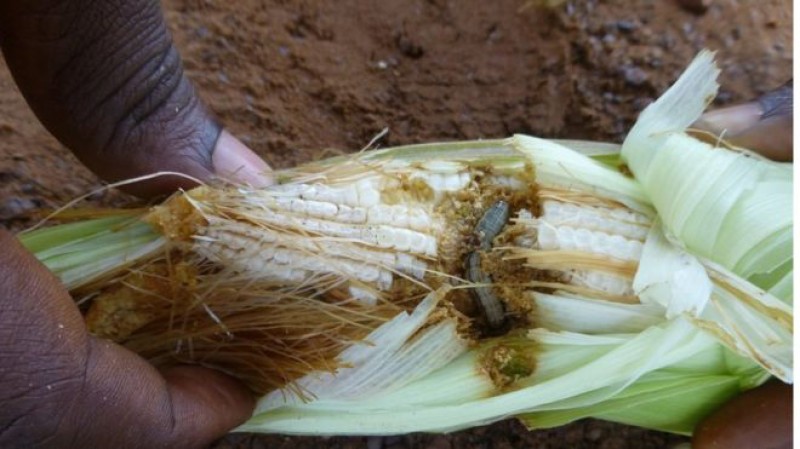Fall Armyworm Threatens To Cause Food Crisis In Botswana
Onalenna Kelebeile | Monday May 28, 2018 13:29


The Fall Armyworm or Spodoptera frugiperda is described in widespread entomology literature, both online and offline, as “a species in the order of Lepidoptera and is the larval life stage of a fall armyworm moth.
“The term “armyworm” can refer to several species, often describing the large-scale invasive behaviour of the species’ larval stage. It is regarded as a pest and can damage and destroy a wide variety of crops, which causes large economic damage. Its scientific name derives from frugiperda, which is Latin for lost fruit, named because of the species’ ability to destroy crops,” said Wikipedia. Locally its spread has the potential to cause damage to the crop that could result in 80% losses, apparently defeating efforts of the country to reduce its already high food import bill.
Since its outbreak in the country last year, the Fall Armyworm quickly ascended the ladder to come tops amongst other constant threats faced by farmers.
Evidently, a threat to the country’s food crisis in looming. At the outset last year, the armyworm was reported across all Botswana districts and currently, the Department of Agricultural Research is rounding up reports from all the districts to see which areas are most affected and the extent of infestation.
The department’s Director, Pharaoh Mosupi said the armyworm has the potential to cause devastating destruction if not dealt with urgently. “We are yet to round up reports for this season for reported cases countrywide to conclude our surveys. It is so destructive and causes serious damage to maize than any other cereal though it can attack 80 different types of plants,” he told The Monitor’s sister paper, Mmegi his week. ,
He noted that maize is one of the most important cereal crops in Botswana, hence efforts have to be put in place to minimise its damage by the armyworm.
He added that farmers are encouraged to monitor, detect and destroy the worm before it enters the maize stalk because once it is there, it cannot be controlled. He said farmers must closely monitor any sign of the attack such as pores on the maize leaves and added that farmers are always alerted of any outbreak. He noted that those who did not have the means to buy insecticides were assisted while others bought for themselves. He feared that if not controlled early, efforts to eliminate the worm may prove futile and its numbers would proliferate across the country.
“We are also currently doing some yield assessment to establish how much loss of yield was incurred in the last ploughing season,” he said. Mosupi added they are conducting research to see how the worm survives after the maize harvest over wintering as traditional method of farming, instead of irrigation, are mostly used by farmers.
“It is crucial to detect early enough and even destroy the eggs. Chances that it is there around the country are very high, but we are yet to confirm its distribution,” he said.
Mosupi further said Africa at large has been invaded by the outbreak and the worms landed by ship in the west and spread across the continent and reached Botswana and other countries in the sub-Saharan region.
It was initially detected in Nigeria in January 2016 and there after it already spread to over 43 African countries.
He added that in America, farmers controlled its spread with the help of genetically modified plants and advanced pesticides. He said by contrast, the armyworm is meeting little resistance in Africa.
Mosupi explained that the reason for its rapid spread is that the armyworm migrates and reproduces much faster.
The moth can fly as far as 100 kilometres per night while a female moth can lay up to 1,000 eggs in 10 days. He also indicated that another challenge is that small holders who use outdated techniques whose yields are already low are the ones who do farming in Africa. “The armyworm strain that is spreading rapidly across sub-Sahara is already ‘preloaded’ with insecticide resistance genes from its native home,” he said.
He noted that they are conducting targeted surveys in armyworm-infested maize fields across the districts to identify maize genotypes that are tolerant to damage by the armyworm. He added that they will also conduct super-imposed assessment of damage levels in damage caused by the worm.
“We will also collect different maize varieties for further on-station evaluation for tolerance against the armyworm.
“Sampling stations will be randomly selected in identified infested fields using a zigzag method. “Survey will be conducted at different agricultural districts where the armyworm has been reported while seeds from promising varieties will be collected for further evaluation,” he added.
Meanwhile, the department is proposing research on the Musi cattle breed for milk production potential to address milk shortage in the country. The country cannot meet the annual demand of 66 million litres of raw milk and the local production stands at only 5.2 million litres and imports 60.8 million litres at P338 million. Not only fresh raw milk is imported, but also diary products such as cheese and powdered milk. The importation is not sustainable hence the need to address the situation. Researcher, Onalethata Basinyi attributed low productivity to lack of dairy breeds. “Botswana does not have her own dairy breed and continues to milk indigenous Tswana and other beef breeds yet the milk shortfall continues.
“As such, development of composite breeds can assist curb the milk deficit,” he said. Basinyi noted that since the country has released a composite cattle breed - Musi, it is thought that it might produce better milk yields, though its milk production potential has not been recorded.
He said the study would determine Musi breed’s milk yield and milk compositional quality. It would also determine its economic performance in terms of the milk production expected outcome.
